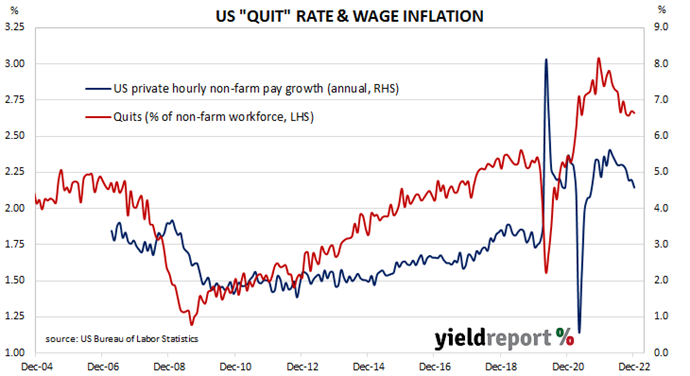Summary: US quit rate steady at 2.7% in December; elevated quit rate a message US labour market “very tight”: US yields down, expectations of higher rates soften; quits down, openings and separations both up; ratio of job openings to unemployed increases to 1.9.
The number of US employees who quit their jobs as a percentage of total employment increased slowly but steadily after the GFC. It peaked in March 2019 and then tracked sideways until virus containment measures were introduced in March 2020. The quit rate then plummeted as alternative employment opportunities rapidly dried up. Following the easing of US pandemic restrictions, it proceeded to recover back to its pre-pandemic rate in the third quarter of 2020 and trended higher through 2021 before easing through 2022.
Figures released as part of the latest Job Openings and Labor Turnover Survey (JOLTS) report show the quit rate remained steady in December. 2.7% of the non-farm workforce left their jobs voluntarily, the same rate after rounding as in November, even as quits in the month declined by 15,000 and an additional 223,000 people were employed in non-farm sectors.
“The quit rate staying elevated at 2.7% sends a similar message as openings that the labour market continues to be very tight,” said Citi analyst Gisela Hoxha.
The figures were published on the same day as several other reports as well as a 25bps increase to the federal funds target range. US Treasury yields moved considerably lower and, by the close of business, 2-year and 10-year Treasury bond yields had both shed 9bps to 4.12% and 3.42% respectively while the 30-year yield finished 7bps lower at 3.57%.
In terms of US Fed policy, expectations of higher federal funds rates over the next 12 months softened. At the close of business, contracts implied the effective federal funds rate would average 4.57% in February, 24bps higher than the current spot rate, and then climb to an average of 4.64% in March. May futures contracts implied a 4.88% average effective federal funds rate while December contracts implied 4.48%.
The decline in total quits was led by 69,000 fewer resignations in the “Transportation, warehousing and utilities” sector while the “Other services” sector experienced the largest gain, increasing by 65,000. Overall, the total number of quits for the month fell from November’s revised figure of 4.102 million to 4.087 million.
Total vacancies at the end of December increased by 0.572 million, or 5.5%, from November’s revised figure of 10.440 million to 11.012 million. The rise was driven by a 409,000 increase in the “Accommodation and food services” sector while the “Information” sector experienced the single largest decrease, falling by 107,000. Overall, 11 out of 18 sectors experienced more job openings than in the previous month.
Total separations increased by 59,000, or 1.0%, from November’s revised figure of 5.831 million to 5.890 million. The rise was led by the “Retail trade” sector where there were 63,000 more separations than in November. Separations increased in 10 of the 18 sectors.
“While still well below the 11.86 million March 2022 peak, the ratio of job openings to unemployed rose from 1.7 to 1.9, a figure the Fed chair has previously indicated he would like to see closer to 1,” said NAB’s Head of FX Strategy (Markets) Ray Attrill.
The “quit” rate time series produced by the JOLTS report is a leading indicator of US hourly pay. As wages account for around 55% of a product’s or service’s price in the US, wage inflation and overall inflation rates tend to be closely related. Former Federal Reserve chief and current Treasury Secretary Janet Yellen was known to pay close attention to it.


